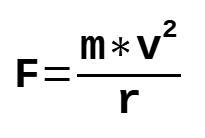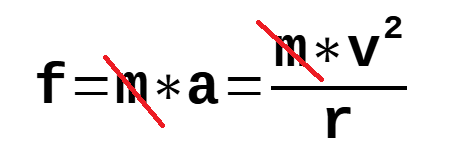Introduction
You are in a spaceship traveling to Saturn. It will take many months to get there. Long exposure to zero g is not healthy for the human body. You must come up with a way to create artificial gravity. You decide to spin the spaceship to create a centripetal force as an artificial gravity.
You must calculate the radius of the spin and how many RPM it will take to create the equivalent of earth's standard gravity (32.1740 ft/sec2) (9.80665 m/sec2).
Centripetal Force Equation

F = centripetal force
m = mass
v = velocity
r = radius

Newton's second law

f = force
m = mass
a = acceleration
Artificial Gravity Equation


a = centripetal acceleration (artificial gravity)
m = mass
v = tangential velocity
r = radius
Notes:
Mass is a measure of how much matter something contains
Mass is a measure of how much force it will take to change its path
Weight is a measure of how strongly gravity pulls
Basic English measurement units are
- length: yard
- mass: slug
- force: pound
- Time: second, minute, hour, ...
The English units of measurement have many drawbacks. For example, the complexity of converting from one unit to another and the use of the same name for different units.
Basic metric measurement units are
- length: meter
- mass: kilogram
- force: newton
- Time: second, minute, hour, ...
- Note: The International System of Units (SI) is the modern name of the metric system.
Convert Mass to Newtons
(metric) Given an average gravity on Earth (g = 9.80665 m/sec2), a 1 kilogram mass exerts a force of about 9.8 newtons (N).
Convert 1 kilogram (of mass) to Newtons (convert kilograms directly to Newtons) 1kg = 1 kg * 9.80665 m/sec2 1 kg = 9.80665 N
(English) Given an average gravity on Earth (g = 32.1740 ft/sec2), a 1 pound mass exerts a force of about 4.44822 newtons (N).
Convert 1 pound (of mass) to Newtons (convert pounds to kilograms then Newtons) 1 lbf = 1 lb * 0.5359237 kg/lb * 9.80665 m/sec2 1 lbf = 4.4482216152605 N
Project #1
Assuming we are trying to duplicate standard gravity. Create a table that engineers can use for preliminary studies. The table should...
- use a radius of 50ft, 100ft, 150ft, 200ft, 250ft, and 300ft
- show rpm (rotations per minute)
- show tangential velocity (feet per minute)
Project #2
Recreate project #1 except use metric units. (kg, m, ...)
Project #3
Create an interactive program that display the resultant artificial gravity value relative to standard gravity (percentage of or fraction of g). Use English units.
- enter tangential velocity and radius, and get a fraction of g
- enter fraction of g and radius, and get tangential velocity
- enter fraction of g and tangential velocity, and get the radius
Project #4
Modify project #3 and allow the user to select metric or English units.
Project #5
Modify project #1 and project #2 to create artificial gravity at 1/4, 1/2, and 3/4 of earth's standard gravity.
1/2 of earth's gravity can be achieved by reducing the centripetal force (artificial gravity) by 1/2; from 32.1740 ft/sec2 to 16.870 ft/sec2 (9.80665 m/sec2 to 4.90332 m/sec2).
RPM Calculation (English)
For 1/2 standard gravity and a radius of 100ft.
- given: radius (r) = 100 (ft)
- given: standard gravity = 32.1741 (ft/sec2)
- given: artificial gravity (a) = 1/2 standard gravity = 16.087 (ft/sec2)
- calc : tangential velocity (t) = sqrt(a*r)= 40.109 (ft/sec)
- calc : tangential velocity (t) = 40.109 * 60 = 2406.54 (ft/min)
- calc : circumference (c) = 2*π*r = 628.318 (ft)
- calc : RPM = t/c = 3.830 (revolutions/minute)
RPM Calculation (metric)
For 1/2 standard gravity and a radius of 100m.
- given: radius (r) = 100 (m)
- given: standard gravity = 9.80665 (m/sec2)
- given: artificial gravity (a) = 1/2 standard gravity = 4.90333 (m/sec2)
- calc : tangential velocity (t) = sqrt(a*r)= 22.143 (m/sec)
- calc : tangential velocity (t) = 22.143 * 60 = 1328.58 (m/min)
- calc : circumference (c) = 2*π*r = 628.318 (m)
- calc : RPM = t/c = 2.1143 (revolutions/minute)
Centripetal Force on 100 lb Object Calculation
For 1/2 standard gravity.
- given: standard gravity = 32.1741 (ft/sec2)
- given: artificial gravity (a) = 1/2 standard gravity = 16.087 (ft/sec2)
- given: force in standard gravity = 100 (lb)
- calc : centripetal force (lb) = 100 * (16.037/32.1741) = 100 * 1/2 = 50 (lb)
- given: standard gravity = 32.1741 (ft/sec2)
- given: artificial gravity (a) = 1/2 standard gravity = 16.087 (ft/sec2)
- given: force in standard gravity (lb) = 100 (lb)
- calc : mass (slugs) = 100 / 32.1741 = 3.1081 (slugs)
- clac : (using f=ma) centripetal force (lb) = 3.1081 * 16.087 = 50 (lb)
Centripetal Force on 100 kg Object Calculation
For 1/2 standard gravity.
- given: standard gravity = 9.80665 (m/sec2)
- given: artificial gravity (a) = 1/2 standard gravity = 4.90333 (m/sec2)
- calc : force in standard gravity = 100 (kg) * 9.80665 (m/sec2) = 980.665 (newtons)
- calc : centripetal force (n) = 980.665 * 1/2 = 490.3325 (n)
Links
Centripetal Force Calculator
Centripetal vs. Centrifugal (word origins)
The difference between mass and weight
Newton (unit) (Wikipedia)
Artificial gravity (Wikipedia)
Weight or Mass?
Definitions, etc.
| F = MA | Force = Mass x Acceleration | kilogram | metric unit of mass (SI unit of mass) a mass that is accelerated by 9.80665 m/s2when a net force of one newton (N) is exerted on it. 1 kilogram weighs 9.80665 Newtons under standard conditions on the Earth's surface. |
slug | English unit of mass a mass that is accelerated by 1 ft/s2when a net force of one pound (lbf) is exerted on it. 1 slug weighs 32.1740 lbs under standard conditions on the Earth's surface. |